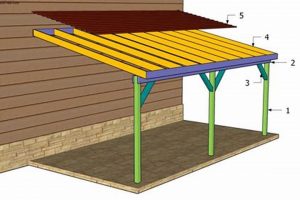The construction and implementation of photovoltaic systems by individuals for residential power generation involves distinct considerations. This approach entails assembling individual components, such as solar cells, wiring, and mounting hardware, to create a functional electricity-producing unit intended for private property. An example is an individual purchasing solar cells and constructing a framework to install on their roof, connecting it to their home electrical system with appropriate inverters and safety mechanisms.
This method offers potential cost savings and increased control over the energy source. The ability to tailor the system to specific energy needs and property characteristics is a significant advantage. Historically, interest in this approach has surged during periods of heightened energy costs and increased environmental awareness, reflecting a desire for energy independence and reduced reliance on traditional utilities.
The subsequent sections will explore the planning, components, construction process, safety considerations, and regulatory landscape associated with the independent construction of residential photovoltaic systems.
Essential Considerations for Residential Photovoltaic System Construction
Careful planning and execution are paramount for ensuring the safety and efficiency of a independently constructed residential photovoltaic system. The following tips outline crucial aspects to consider throughout the process.
Tip 1: Conduct a Thorough Site Assessment: Evaluate roof orientation, angle, shading, and structural integrity to determine optimal panel placement and system performance. Professional structural engineers should be consulted to verify load-bearing capacity before installation.
Tip 2: Select High-Quality Components: Opt for solar cells, inverters, wiring, and mounting hardware that meet established industry standards and carry relevant certifications. Prioritize components with robust warranties and proven reliability to minimize future maintenance and replacement costs.
Tip 3: Adhere to Electrical Safety Standards: Employ appropriate grounding techniques, overcurrent protection devices, and disconnect switches to mitigate the risk of electrical shock and fire hazards. Ensure compliance with local electrical codes and regulations throughout the installation process.
Tip 4: Implement a Robust Mounting System: Choose a mounting system that is specifically designed for the roof type and local weather conditions. Properly secure panels to prevent displacement due to wind, snow, or seismic activity.
Tip 5: Ensure Proper Wiring and Connections: Use appropriately sized wiring and weatherproof connectors to minimize voltage drop and prevent corrosion. Follow established wiring diagrams and best practices to ensure reliable electrical connections.
Tip 6: Obtain Necessary Permits and Inspections: Research and comply with all local building codes, electrical codes, and permitting requirements. Schedule inspections by qualified professionals to ensure that the installation meets safety and performance standards.
Tip 7: Prioritize System Monitoring and Maintenance: Implement a system for monitoring energy production and identifying potential issues. Conduct regular inspections to identify and address any signs of degradation, damage, or malfunction.
Implementing these measures can contribute to a successful and sustainable energy solution. Adhering to safety guidelines and local regulations is critical for achieving optimal performance and long-term energy independence.
The subsequent section will further explore specific technical considerations and provide resources for continued learning and support.
1. Efficiency
Efficiency in the context of constructing photovoltaic systems for residential use refers to the ratio of electrical energy output to the solar energy input. This metric is a critical determinant of the system’s overall performance and economic viability. Lower efficiency necessitates a larger surface area of solar panels to generate a comparable amount of electricity as a high-efficiency system. Selecting high-efficiency solar cells and inverters is therefore fundamental to optimizing energy production, especially in locations with limited roof space or suboptimal sun exposure.
Several factors can significantly impact the efficiency of a constructed photovoltaic array. Panel placement, shading from nearby objects, and the operating temperature of the panels all contribute to potential energy losses. Proper orientation towards the sun, combined with effective ventilation to mitigate overheating, is essential. Furthermore, the use of Maximum Power Point Tracking (MPPT) inverters ensures that the panels operate at their peak efficiency point under varying irradiance conditions. A real-world example illustrates this: A poorly positioned system overshadowed for a portion of the day may only achieve 60% of its potential energy production, contrasting sharply with a well-designed, unshaded system achieving 90% or more.
Maximizing efficiency involves a multi-faceted approach encompassing component selection, careful installation, and ongoing monitoring. Understanding these variables and their interconnectedness is crucial for individuals building photovoltaic systems to achieve the desired energy output and return on investment. Neglecting efficiency considerations can result in a system that underperforms expectations, leading to prolonged payback periods and reduced long-term cost savings.
2. Safety
The integration of safety protocols within independently constructed residential photovoltaic systems is of paramount importance. These systems, involving high-voltage electricity and rooftop installations, present inherent risks that necessitate diligent attention to established safety standards and practices.
- Electrical Shock Hazards
Implemented photovoltaic systems generate direct current (DC) electricity at potentially lethal voltages. Improper wiring, inadequate insulation, or contact with energized components can result in severe electrical shock or electrocution. Grounding techniques, the use of appropriate personal protective equipment (PPE), and strict adherence to electrical codes are essential preventative measures. An example of potential danger is touching a damaged wire on a sunny day during repair with bare hands. This highlights the constant awareness of the electricity being created when exposed to the sun.
- Fire Hazards
Faulty wiring, loose connections, and the use of substandard components can create resistive heating, leading to fire hazards. Overcurrent protection devices, such as fuses and circuit breakers, must be appropriately sized and installed to prevent electrical overloads and short circuits. Regular inspections of wiring and connections are crucial to identify and addre
ss potential fire risks. Poorly installed components may cause arcing and ignition in materials on or surrounding the electrical box. - Fall Hazards
The installation and maintenance of photovoltaic arrays often require working at heights. Fall protection measures, including harnesses, lifelines, and guardrails, are essential to prevent falls from roofs or other elevated surfaces. Thorough planning, proper training, and the use of appropriate equipment are critical for minimizing fall hazards. For example, working on a sloped roof during wet conditions is more dangerous than working on a flat dry surface.
- Structural Integrity
The weight of solar panels and mounting hardware can place significant stress on roof structures. Before installation, a qualified structural engineer must assess the roof’s load-bearing capacity to ensure that it can safely support the added weight. Inadequate structural support can lead to roof collapse, causing property damage and potential injuries. A house designed for wind or earthquakes must be assessed before any system is installed.
Mitigating safety risks associated with independently constructed photovoltaic systems necessitates a comprehensive approach encompassing proper training, adherence to safety standards, and the use of appropriate equipment. Neglecting these considerations can have severe consequences, underscoring the importance of prioritizing safety throughout the entire lifecycle of the system. A properly designed, permitted, and installed system by a qualified professional will minimize most safety risks.
3. Cost-Effectiveness
Cost-effectiveness is a central consideration for individuals undertaking the construction of residential photovoltaic systems. Evaluating the economic benefits relative to the incurred expenses determines the financial viability of this endeavor. Several factors influence the overall cost-effectiveness of such systems.
- Component Acquisition Costs
The upfront investment in solar panels, inverters, mounting hardware, and wiring constitutes a significant portion of the total system cost. Price variations exist across different manufacturers and suppliers. Sourcing components from less reputable sources may reduce initial expenses but could compromise system performance, longevity, and safety. Purchasing higher-quality, certified components, while increasing the initial investment, can result in greater energy production, reduced maintenance needs, and a longer operational lifespan, ultimately enhancing long-term cost-effectiveness. For example, a system built with Tier 1 panels will likely have a significantly higher initial cost than a system built with lower-quality panels, however, it may produce more electricity over its lifespan.
- Labor and Installation Expenses
Engaging professional installers adds to the overall cost. However, employing qualified technicians ensures adherence to electrical codes, proper system configuration, and safe installation practices. A system installed without proper permitting or inspection may require costly remediation to meet regulatory requirements. The cost of self-installation, although seemingly eliminating labor expenses, must account for the time invested, potential errors that may require rectification, and the risk of voiding product warranties. The economic value of personal time must be considered, especially if that time could be spent on other income-generating activities.
- Government Incentives and Rebates
Federal, state, and local governments often offer financial incentives, such as tax credits, rebates, and grants, to encourage the adoption of renewable energy technologies. These incentives can significantly reduce the net cost of a independently constructed solar system. Eligibility requirements and application procedures vary by jurisdiction. Failure to adequately research and apply for available incentives represents a missed opportunity to improve the system’s cost-effectiveness. For example, the federal investment tax credit (ITC) provides a percentage deduction on the total cost of the system. State and local incentives can range from direct rebates to property tax exemptions.
- Operational and Maintenance Costs
Solar panel systems require minimal maintenance, but periodic inspections and cleaning are necessary to ensure optimal performance. Inverter replacements, which may be required every 10-15 years, represent a significant operational expense. Monitoring system performance allows for early detection of potential problems, preventing costly repairs and maximizing energy production. Neglecting maintenance can lead to reduced efficiency, increased downtime, and premature component failure, thereby diminishing the system’s overall cost-effectiveness. Monitoring can also track the energy created and the cost savings for the homeowner.
Balancing upfront costs with long-term performance, maintenance requirements, and available incentives is crucial when evaluating the cost-effectiveness of residential photovoltaic systems. A comprehensive financial analysis, including a life-cycle cost assessment, provides a framework for making informed decisions that align with individual energy needs and economic goals. Accurately evaluating these factors will yield the most viable system for the homeowner.
4. Regulations
Adherence to regulations constitutes a critical facet of constructing residential photovoltaic systems. Compliance with established codes and standards governs the safety, performance, and legality of such installations. Failure to meet regulatory requirements can result in significant consequences, ranging from project delays and financial penalties to system shutdowns and legal liabilities. These regulations are implemented at the local, state, and federal levels, reflecting a tiered approach to oversight. For example, local building codes typically dictate structural requirements and electrical safety standards, while state regulations may address grid interconnection protocols and renewable energy portfolio standards. Federal incentives, such as tax credits, are contingent upon compliance with specific technical criteria and installation practices.
The process of navigating these regulatory landscapes necessitates diligent research and proactive engagement with relevant authorities. Obtaining the necessary permits and approvals often involves submitting detailed system designs, electrical schematics, and structural calculations. Inspections by qualified electrical inspectors and building officials are typically required to verify compliance with applicable codes and standards. Interconnecting a independently constructed system to the utility grid requires adherence to specific interconnection agreements and technical specifications established by the local utility provider. Non-compliance with these requirements can lead to denial of interconnection, rendering the system unable to export excess energy back to the grid. Moreover, insurance providers may deny coverage for systems that do not meet regulatory standards, leaving homeowners financially vulnerable in the event of damage or liability claims.
In summary, regulations represent an indispensable component of constructing residential photovoltaic systems. Thorough understanding and proactive adherence to these regulations are essential for ensuring the safety, legality
, and long-term viability of these installations. Navigating the regulatory landscape requires careful planning, diligent research, and collaboration with qualified professionals to secure the necessary permits, approvals, and inspections. Prioritizing regulatory compliance not only mitigates potential risks but also fosters public trust in the widespread adoption of residential photovoltaic systems as a safe and sustainable energy solution.
5. Maintenance
The sustained performance of independently constructed residential photovoltaic systems is directly contingent upon diligent maintenance practices. Reduced energy output, system failures, and compromised safety can arise from neglecting regular inspection and upkeep. The complexity of maintenance requirements, influenced by environmental conditions, component quality, and installation specifics, necessitates a proactive approach.
Effective maintenance of self-installed photovoltaic systems involves several critical aspects. Periodic cleaning of solar panels is essential to remove accumulated dirt, dust, pollen, and debris that can impede sunlight absorption, thereby reducing energy generation efficiency. Visual inspections of wiring, connections, and mounting hardware are necessary to identify potential issues such as corrosion, loose fittings, or structural damage. Monitoring system performance data, typically accessible through inverter monitoring systems, enables early detection of performance anomalies indicative of component malfunction or system degradation. Corrective actions, such as tightening connections, replacing damaged wiring, or repairing mounting structures, should be performed promptly to prevent further deterioration and ensure system integrity. For example, a homeowner notices that their system’s output is lower than expected during peak sunlight hours. After inspecting the panels, they discover a buildup of bird droppings significantly reducing the amount of sunlight reaching the cells. After cleaning the panels, the system’s output returns to normal. A well-maintained system provides a reliable electricity source and maximizes the return on investment.
In conclusion, maintenance is an indispensable element in the successful operation of independent residential photovoltaic systems. Proactive maintenance practices not only enhance energy output and system lifespan but also mitigate potential safety hazards and prevent costly repairs. By integrating routine inspection, cleaning, and performance monitoring into their system management strategy, individuals can ensure the long-term reliability and cost-effectiveness of their independently constructed solar energy investment. Proper maintenance is not just an optional task; it is a critical responsibility of the homeowner.
6. Longevity
The long-term operational lifespan of independently constructed residential photovoltaic systems is a critical factor in determining their economic viability and sustainability. The investment in components and labor necessitates a system that maintains performance over an extended period to generate a satisfactory return. Several factors directly impact the longevity of these systems.
- Component Quality and Selection
The durability of solar panels, inverters, and other system components directly influences the overall lifespan. Solar panels manufactured with high-quality materials and rigorous quality control processes typically exhibit lower degradation rates and longer operational lifespans. Similarly, selecting inverters with robust designs and proven reliability minimizes the risk of premature failure. Using substandard components may reduce upfront costs but often results in significantly shorter lifespans, thereby diminishing the system’s long-term cost-effectiveness. As an example, a homeowner selecting panels with a 25-year performance warranty is prioritizing longevity, whereas using panels with a shorter warranty may necessitate earlier replacement.
- Environmental Factors and Weather Resistance
Exposure to environmental stressors, such as ultraviolet radiation, temperature fluctuations, humidity, and extreme weather conditions, can accelerate the degradation of system components. Solar panels and mounting hardware must be able to withstand these elements to maintain structural integrity and performance over time. Choosing components designed for specific climate conditions, such as high-wind resistance or corrosion protection, is crucial for maximizing lifespan. A coastal installation, for example, demands components with superior corrosion resistance compared to a system located in a dry, temperate climate. Similarly, locations with heavy snowfall require mounting systems designed to handle significant weight loads.
- Installation Quality and Workmanship
Proper installation techniques and meticulous attention to detail are essential for ensuring long-term system reliability. Secure mounting, weatherproof wiring connections, and adherence to electrical codes minimize the risk of premature failure due to mechanical stress, water damage, or electrical faults. Poor workmanship, such as improperly tightened connections or inadequate grounding, can lead to accelerated component degradation and increased maintenance requirements, significantly reducing the system’s lifespan. A system with correctly torqued connections and well-protected wiring will exhibit higher reliability compared to a system with haphazard wiring and loose fittings.
- Maintenance and Monitoring Practices
Regular inspections, cleaning, and performance monitoring contribute significantly to extending the lifespan of independently constructed photovoltaic systems. Identifying and addressing potential issues, such as loose connections, damaged wiring, or panel degradation, allows for timely corrective actions that prevent further deterioration. Maintaining clean panel surfaces maximizes energy production, while monitoring system performance data enables early detection of component malfunctions. A homeowner who proactively inspects and cleans their panels annually, compared to one who neglects maintenance, is more likely to achieve the system’s full intended lifespan.
The interplay of these factors determines the longevity of photovoltaic installations. Selecting high-quality components, employing robust installation techniques, and adhering to diligent maintenance practices are critical for maximizing the operational lifespan and ensuring the long-term economic viability of these systems. Neglecting these considerations can lead to premature system failure, increased maintenance costs, and a diminished return on investment.
Frequently Asked Questions
The following questions address common inquiries regarding the construction and implementation of residential photovoltaic systems, focusing on key considerations and potential challenges.
Question 1: What level of technical expertise is required to construct a residential photovoltaic system?
Constructing a residential photovoltaic system necessitates a comprehensive understanding of electrical principles, wiring practices, and safety protocols. Familiarity with structural engineering concepts is also beneficial. While novice builders can attempt simpler configurations, complex installations typically necessitate the involvement of qualified electricians and structural engineers.
Question 2: What are the primary safe
ty considerations during the installation process?
Safety during the installation is critical. The primary safety considerations include electrical shock hazards, fall hazards, and structural integrity concerns. Implementing appropriate grounding techniques, employing personal protective equipment, and ensuring compliance with building codes are essential. A structural engineer must evaluate the roof’s load-bearing capacity before installation.
Question 3: How does one ensure compliance with local building codes and regulations?
Compliance with local building codes and regulations involves researching permitting requirements, submitting detailed system designs and electrical schematics, and scheduling inspections by qualified professionals. Adherence to grid interconnection agreements established by the local utility provider is also necessary.
Question 4: What are the potential long-term maintenance requirements for residential photovoltaic systems?
Maintenance involves periodic cleaning of solar panels, visual inspections of wiring and connections, and monitoring system performance data. Corrective actions, such as tightening connections or replacing damaged components, should be performed promptly to prevent further deterioration.
Question 5: How does one determine the optimal size and configuration for a residential photovoltaic system?
Determining the optimal size and configuration requires assessing the household’s energy consumption patterns, evaluating roof orientation and shading conditions, and calculating the expected energy production based on local solar irradiance levels. Online tools and professional consultations can assist in this determination.
Question 6: What are the potential cost savings associated with constructing a residential photovoltaic system?
The potential cost savings are a reduction in electricity bills, tax incentives, and rebates. Long-term savings depend on factors such as system size, energy consumption patterns, and prevailing electricity rates. A comprehensive financial analysis is crucial for accurately assessing potential savings.
In summary, constructing a residential photovoltaic system requires a careful balance of technical expertise, safety precautions, regulatory compliance, and financial planning. A thorough understanding of these factors is crucial for achieving a successful and sustainable energy solution.
The following section will further explore advanced techniques and emerging trends in the realm of independently constructed residential photovoltaic systems.
Conclusion
The preceding exploration of the practice reveals a multifaceted undertaking requiring meticulous planning, rigorous execution, and ongoing vigilance. The successful implementation of residential photovoltaic systems hinges upon a comprehensive understanding of electrical engineering principles, safety protocols, regulatory compliance, and maintenance practices. Shortcomings in any of these areas can compromise system performance, longevity, and overall safety.
The adoption of photovoltaic technology for residential power generation presents an opportunity to mitigate energy costs and promote environmental sustainability. However, the long-term success of such endeavors necessitates a commitment to responsible practices and continuous learning. Individuals considering should carefully weigh the potential benefits against the inherent risks and complexities involved.




![Diya Aur Baati Hum: Illuminate Your Home [DIY Guide] The DIY Hub: Creative Crafts, Repairs & Life Hacks Diya Aur Baati Hum: Illuminate Your Home [DIY Guide] | The DIY Hub: Creative Crafts, Repairs & Life Hacks](https://craftingdiycenter.com/wp-content/uploads/2025/07/th-5913-300x200.jpg)


